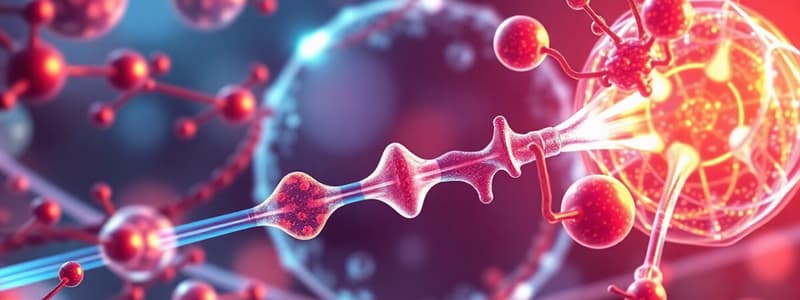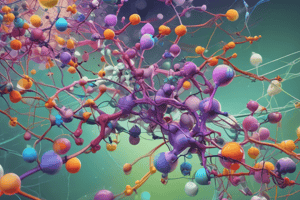Podcast
Questions and Answers
What is the name of the first stage of the drug discovery process?
What is the name of the first stage of the drug discovery process?
Target Identification
What are the four main mechanistic categories of enzyme inhibition?
What are the four main mechanistic categories of enzyme inhibition?
- Competitive Inhibition, Uncompetitive Inhibition, Allosteric Inhibition, Irreversible Inhibition
- Competitive Inhibition, Uncompetitive Inhibition, Non-competitive Inhibition, Reversible Inhibition
- Competitive Inhibition, Allosteric Inhibition, Non-competitive Inhibition, Irreversible Inhibition
- Competitive Inhibition, Uncompetitive Inhibition , Non-competitive Inhibition, Irreversible Inhibition (correct)
What is the name of the process when an inhibitor binds non-covalently to sites other than the active site of an enzyme?
What is the name of the process when an inhibitor binds non-covalently to sites other than the active site of an enzyme?
Allosteric Inhibition
Irreversible inhibition occurs when an inhibitor binds covalently to the active site of an enzyme.
Irreversible inhibition occurs when an inhibitor binds covalently to the active site of an enzyme.
The active site of an enzyme is tailored to bind the ______ state of the substrate for S->P
The active site of an enzyme is tailored to bind the ______ state of the substrate for S->P
What are the four mechanistic classes of proteases?
What are the four mechanistic classes of proteases?
What type of inhibitor is typically used to target serine proteases?
What type of inhibitor is typically used to target serine proteases?
What type of receptor is responsible for the majority of known examples of receptors?
What type of receptor is responsible for the majority of known examples of receptors?
Endogenous agonists often bind weakly to receptors.
Endogenous agonists often bind weakly to receptors.
Which of the following ions are involved in ion channels?
Which of the following ions are involved in ion channels?
What is the name of the ion channel that is responsible for the prolongation of cardiac Q-T interval?
What is the name of the ion channel that is responsible for the prolongation of cardiac Q-T interval?
Ligands can include other ions, small molecules, toxins, and venoms.
Ligands can include other ions, small molecules, toxins, and venoms.
What is the class of blockbuster antihypertensive drugs that have emerged from calcium channel antagonist programmes?
What is the class of blockbuster antihypertensive drugs that have emerged from calcium channel antagonist programmes?
What are the two main classes of ion channels?
What are the two main classes of ion channels?
Flashcards
Drug Discovery Process
Drug Discovery Process
A series of steps to find and develop new medications.
Target Identification
Target Identification
Identifying a biological target (e.g., protein) to be treated by a drug.
High-Throughput Screening (HTS)
High-Throughput Screening (HTS)
Testing many compounds against a target to find potential "hits".
Active-to-Hit (AtH)
Active-to-Hit (AtH)
Signup and view all the flashcards
Hit-to-Lead (HtL)
Hit-to-Lead (HtL)
Signup and view all the flashcards
Lead Optimization (LO)
Lead Optimization (LO)
Signup and view all the flashcards
Candidate Drug (CD)
Candidate Drug (CD)
Signup and view all the flashcards
Biological Mechanisms
Biological Mechanisms
Signup and view all the flashcards
Receptor
Receptor
Signup and view all the flashcards
Enzyme
Enzyme
Signup and view all the flashcards
Ion Channel
Ion Channel
Signup and view all the flashcards
Competitive Inhibition
Competitive Inhibition
Signup and view all the flashcards
Uncompetitive Inhibition
Uncompetitive Inhibition
Signup and view all the flashcards
Non-competitive Inhibition
Non-competitive Inhibition
Signup and view all the flashcards
Irreversible Inhibition
Irreversible Inhibition
Signup and view all the flashcards
Protease
Protease
Signup and view all the flashcards
Serine Protease
Serine Protease
Signup and view all the flashcards
Catalytic Triad
Catalytic Triad
Signup and view all the flashcards
Receptor Agonist
Receptor Agonist
Signup and view all the flashcards
Receptor Antagonist
Receptor Antagonist
Signup and view all the flashcards
Ion channel
Ion channel
Signup and view all the flashcards
Voltage-gated ion channel
Voltage-gated ion channel
Signup and view all the flashcards
Ligand-gated ion channel
Ligand-gated ion channel
Signup and view all the flashcards
Study Notes
Advanced Medicinal Chemistry - Lecture 1: Target Classes
- The lecture is about target classes in advanced medicinal chemistry.
- The drug discovery process has stages: target identification (3-24 months), HTS (3-4 months), Active-to-Hit (AtH) ( 3 months), Hit-to-Lead (HtL) (6-9 months), New Lead Optimisation Projects (LO) (2 years), and Candidate Drug (CD) (2 years).
- Biological mechanisms include receptors (agonists, antagonists, partial agonists, inverse agonists), enzymes (inhibitors), ion channels (openers, blockers), and protein-protein inhibitors.
- Effective drugs, such as Lipitor (HMG CoA inhibitor, $12 billion), Plavix (anti-platelet, $5 billion), Nexium (proton pump inhibitor, $4.8 billion), and Norvasc (calcium channel blocker, $4.8 billion) are part of blockbuster drugs from a list of the top 50 drugs from worldwide sales of 2005.
- Enzyme function involves an active site that binds to the transition state for substrate (S) to product (P).
- Enzyme inhibition can be competitive, uncompetitive, non-competitive (allosteric), or irreversible (suicide).
- Proteases (proteinases, peptidases) hydrolytically cleave peptide amide bonds. They have four mechanistic classes: serine, cysteine, aspartic, and zinc.
- Protease specificity is determined by the binding of substrate amino acid side-chains near the cleavage site. Specific pocket nomenclature is used.
- Serine proteases like thrombin, tryptase, beta-lactamase, elastase, chymotrypsin, and HCV-NS3 have a catalytic triad that boosts serine nucleophilicity.
- Receptors are membrane-bound proteins that bind endogenous ligands (usually extracellular) to induce a physiological effect (usually intracellular).
- G-protein coupled, seven transmembrane spanning receptors are major types of receptors.
- α-adrenoceptors are a type of receptor.
- Binding to Receptors: Agonists bind and induce a signal. Antagonists bind and block signals.
- Ligands can be proteins, peptides, or small molecules.
- Agonists and antagonists bind competitively. Endogenous agonists often bind weakly, while successful antagonists bind tightly.
- Ion channels regulate passive ion flow across membranes dependent on electrical or concentration gradients, and some involve ion channels like hERG (iKr).
- Ion channels can be voltage-gated or ligand-gated. Ligands for ion channels can be other ions, small molecules, or toxins and venoms.
Studying That Suits You
Use AI to generate personalized quizzes and flashcards to suit your learning preferences.




